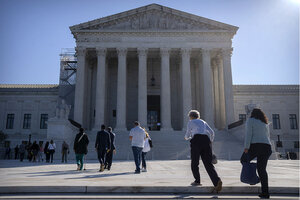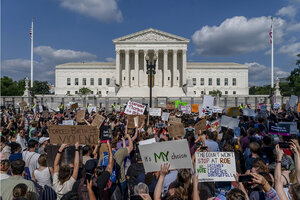As Supreme Court starts new term, how far right is it headed?

Visitors walk across the plaza in front of the Supreme Court on opening day of the new term, Oct. 2, 2023, in Washington.
Mark Schiefelbein/AP
The U.S. Supreme Court began a new term this week, and it began with a dose of skepticism.
During oral argument on Tuesday, several justices – including members of the high court’s robust conservative majority – questioned an appeals court holding that a federal consumer protection agency’s fundraising mechanism is unconstitutional.
It’s unclear how the court will rule in the case, but the argument is an early indication that while this may be the most conservative Supreme Court in nearly a century, it still has standards and limits.
Why We Wrote This
A theme of the term is likely to be consequences, with the court wrestling with the fallout from some of its landmark conservative rulings.
In some cases, the high court is facing the reverberations of its recent landmark rulings. In other cases, the court could deliver more rulings that conservatives have long pushed for. And then there’s former President Donald Trump, who is facing 91 felony charges amid four cases in state and federal court. Those cases are likely to be appealed and may reach the Supreme Court.
But after a summer clouded by ethics controversies, the justices have returned to regularly scheduled programming to face, in various guises, the same question: How far right will they push the envelope?
What are the big cases this term?
The argument Tuesday involved one of the term’s big cases, and one of the term’s big legal issues: the independence of federal agencies.
The even more conservative U.S. Court of Appeals for the 5th Circuit is a central player here. Some of the biggest cases the justices have agreed to hear this term involve appeals to rulings from that circuit, Tuesday’s case involving the U.S. Consumer Financial Protection Bureau.
In that case, the circuit court declared the agency’s entire funding mechanism unconstitutional – a mechanism that Congress has authorized for various federal programs for decades, including currently Medicare and Medicaid. During the argument, even some conservative justices struggled to understand the lower court ruling.
Congress may have “never gone this far” with that kind of funding mechanism before, said Justice Clarence Thomas, “but ... not having gone this far is not a constitutional problem.”
The Supreme Court-5th Circuit dynamic will be watched closely this term. Both courts have been reshaped in recent years, particularly by former President Trump. He appointed one-third of the current Supreme Court and six of 17 active 5th Circuit judges.
While moderate conservative justices rejected some of the more extreme arguments the court heard last term, experts say the 5th Circuit, which hears cases arising from deep-red Texas, Louisiana, and Mississippi, has been more cavalier.
“You might say, why does the court have this focus on administrative law [this term]? Or you might say, why is the 5th Circuit issuing these remarkably extreme opinions?” says Carolyn Shapiro, a professor at the Chicago-Kent College of Law.
“The 5th Circuit is doing some very extreme things, and the Supreme Court is almost always going to grant” appeals so those decisions can be reviewed, she adds.
What else can we expect?
Another theme of the term is likely to be consequences.
Since a six-justice conservative supermajority took control of the Supreme Court three years ago, several legal priorities – including expanding gun rights and eliminating the constitutional right to abortion and race-based affirmative action in college admissions – have been addressed. This term will also see the court wrestle with the fallout from some of those rulings.
In 2022, for example, the court held that the Second Amendment guaranteed everyone the right to carry a firearm. Any restriction on that right must be consistent with the “history and tradition” of American gun policy, the court added, with little elaboration.
In a case scheduled for argument next month, the justices will have to elaborate. Specifically, does this history and tradition test mean the government can restrict people who are subject to domestic violence restraining orders from carrying guns?
The abortion issue could also return to the high court. An effort to revoke federal approval for a widely prescribed abortion pill already reached the justices, on an emergency basis, earlier this year, where they granted an emergency stay keeping the pill available. It’s possible the court will be asked to give the case a full hearing.
“The Supreme Court seems to have sent very strong signals to the conservative legal movement that it’s open for business,” says Steven Schwinn, a professor at the University of Illinois, Chicago School of Law. “But it hasn’t fully thought through what that means down the road.”
Are there other cases about the “administrative state”?
Yes, and the court will likely be more interested in restricting federal agencies in these other cases.
In another case from the 5th Circuit, the court will decide if the U.S. Securities and Exchange Commission can impose civil penalties for securities fraud. The ruling could implicate the administrative powers of agencies from the Food and Drug Administration to the Postal Service.
But another case, and one of the most high-profile of the term, is asking the justices to overturn the Chevron doctrine.
The doctrine, first articulated by the Supreme Court in 1984, holds that federal courts must defer to an agency’s interpretation of ambiguous statutes if it’s based on “a permissible construction” of the statute. Conservatives charge that Chevron has given federal agencies too much regulatory power over Americans’ daily lives, and several justices have openly criticized the doctrine.
“Together [those three cases] all put the court in the position of making clear how far it really wants to go in terms of curtailing the administrative state,” says Jonathan Adler, a professor at Case Western Reserve University School of Law.
“The court has already cut back on Chevron, and the way the question is presented, the court could cut back more without directly overturning the decision.”
Consequences are also likely to come into play with the three administrative law cases. The court has been willing to limit agency power in recent years, for example, but it’s been careful to do so in a way that doesn’t throw into question decades of agency actions, says Professor Adler.
“This term, the ability of the court to continue to sound those themes without [creating] significant consequences is more concerning,” he adds. “The court is going to have to think more carefully about the potential consequences. ... We’ll see if that affects how the court decides cases.”
Wasn’t there lots of Supreme Court ethics news earlier this year?
Yes there was. Unlike other federal judges, Supreme Court justices are not subject to any formal ethics rules. And while people disagree over how big a problem it is, most agree that justices across the ideological spectrum have been able to make ethically suspect choices.
According to news reports, Justice Thomas and Justice Samuel Alito for years failed to disclose numerous gifts, including luxury vacations, from conservative donors and legal activists. Justice Sonia Sotomayor has been similarly criticized for reports that she encouraged public institutions to buy her books ahead of speaking engagements, and that she failed to recuse herself from cases involving her publisher.
“It heightens people’s concerns about the court, and to the extent they’re issuing opinions that are unpopular ... those concerns will continue,” says Professor Shapiro.
Justice Alito and Chief Justice John Roberts have brushed off the ethics concerns, the latter citing “separation of powers concerns and the importance of preserving judicial independence.” The court did adopt tighter reporting rules over the summer, but Justice Brett Kavanaugh and Justice Elena Kagan have both said in the past month that the high court should take additional steps to address concerns about its ethics rules.
In a relatively surprising decision this week, Justice Thomas recused himself from a decision rejecting an appeal in a case involving efforts to overturn the 2020 election. Justices don’t have to explain recusal decisions, but the fact that a plaintiff in the case, John Eastman, clerked for Justice Thomas in the mid-1990s could be a reason. Still, court watchers say, it represents a departure for Justice Thomas, who had refused to recuse himself from similar cases in the past despite evidence his wife, Ginni, was involved in efforts to overturn the 2020 election.
The recusal “should not be big news,” said Joyce White Vance, a law professor and former federal prosecutor, on social media. “But in this day and age ... it is.”
Meanwhile, public approval of the Supreme Court is now at 40%, a record low, according to Gallup. Another potentially contentious term lies ahead.


